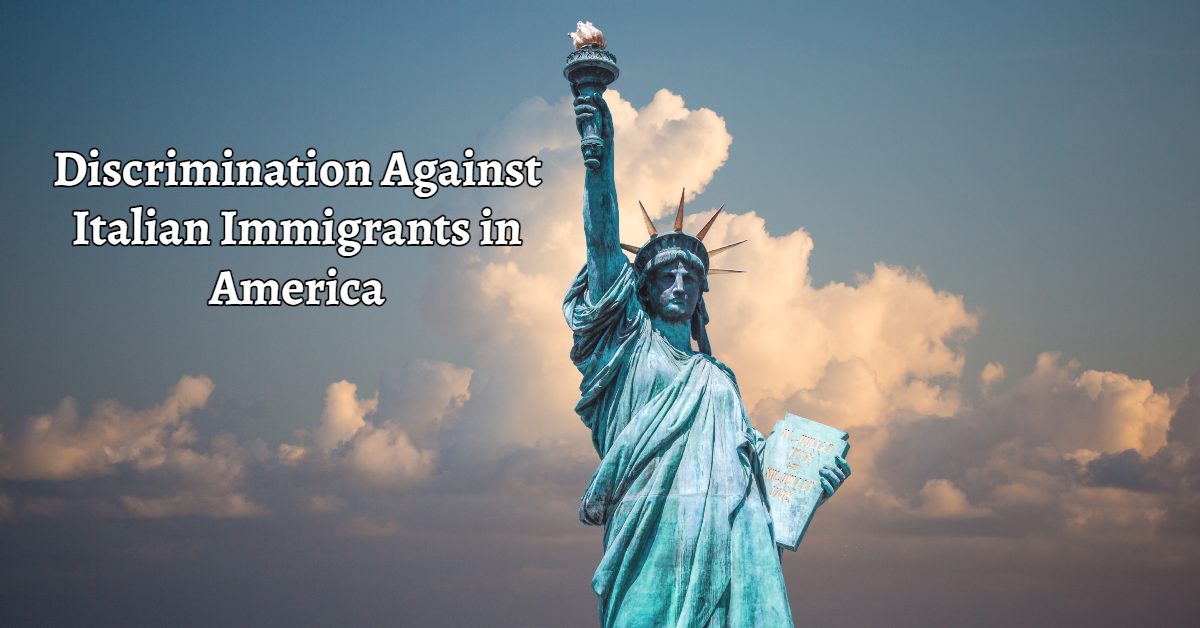First-generation Italian immigrants faced numerous challenges when they came to the United States in the late 19th and early 20th centuries. Discrimination and defamation were among the most significant challenges that they had to deal with.
One of the primary forms of discrimination that Italian immigrants faced was racial prejudice. Many Americans at the time believed that Italians were racially inferior and inherently prone to criminal behavior. This stereotype was reinforced by the media, which often depicted Italians as violent and dangerous. This led to discrimination in employment, housing, and education, making it difficult for Italian immigrants to improve their economic status.
Linguistic Discrimination of Italian Immigrants
Italian immigrants also faced linguistic discrimination. Many Americans viewed Italian as a “foreign” language and refused to do business with Italians who did not speak English. This made it difficult for Italian immigrants to find jobs and participate fully in American society.
Many Americans at the time believed that immigrants should learn English and assimilate to American culture quickly. However, this was easier said than done, especially for Italian immigrants who often came from rural areas where Italian was the primary language spoken. Moreover, Italian is a very different language from English, and it can be challenging to learn quickly.
In many cases, Italian immigrants were subjected to discrimination and even ridicule because of their limited English language skills. They were often viewed as “foreign” and “uneducated,” which made it difficult for them to find employment and housing. In some cases, Italian immigrants were denied access to schools or other services because of their limited English proficiency.
Furthermore, some American employers refused to hire Italian immigrants who did not speak English fluently, regardless of their qualifications or skills. This made it challenging for Italian immigrants to find work and support their families. As a result, many Italian immigrants had to take on low-paying jobs or work in dangerous and unhealthy conditions.
Stereotypes of Italian Immigrants in America
Italian immigrants were also subject to defamation. Italian-Americans were often associated with organized crime, and some members of the Italian-American community did engage in criminal activities. However, this stereotype was applied to all Italian-Americans, regardless of their actual involvement in criminal activity.

This led to a general suspicion of Italian-Americans and made it difficult for them to gain acceptance in American society. This stereotype was perpetuated by the media and reinforced by high-profile cases involving Italian-American criminals, such as the infamous murder trial of Sacco and Vanzetti in the 1920s. This stereotype was not only untrue, but it also led to the criminalization and marginalization of Italian immigrants in American society.
Another stereotype about Italian immigrants was that they were uneducated and uncivilized. This stereotype was based on the belief that Italian immigrants came from rural, backward regions of Italy and were not suited to modern, urban American life. This stereotype was also untrue, as many Italian immigrants were highly educated and skilled in various trades and professions.
Italian immigrants were also subject to other myths and stereotypes, such as that they were lazy and refused to work, that they were clannish and unwilling to assimilate, and that they were all involved in organized crime. These stereotypes were often used to justify discrimination and exclusion of Italian immigrants from American society.
Despite the persistence of these stereotypes, Italian immigrants were able to overcome them and make significant contributions to American society. Italian-Americans have excelled in various fields, including politics, entertainment, sports, and business, and have enriched American culture with their unique heritage and traditions.
Today, it is important to remember the struggles and challenges faced by Italian immigrants in America and to recognize the contributions they have made to American society. Stereotypes and myths about immigrants, whether Italian or otherwise, are harmful and have no place in a diverse and inclusive society.
Other Types of Discrimination Against Italians in America
Italian immigrants also faced discrimination from the government. Immigration policies in the early 20th century had a significant impact on Italian immigrants who were seeking to come to the United States. During this time, the US government implemented a number of policies that specifically targeted Italian immigrants and other southern and eastern Europeans.
One of the most significant policies was the Immigration Act of 1924, also known as the Johnson-Reed Act. This law established quotas for the number of immigrants allowed to enter the United States from each country.
The quotas were based on the number of immigrants already living in the US from each country, with the goal of limiting immigration from southern and eastern Europe. This had a disproportionate impact on Italian immigrants, who were among the largest groups affected by the quotas.
Additionally, Italian immigrants were often subject to more rigorous medical and legal screenings than other immigrants. This was due to the belief that southern and eastern Europeans were more likely to carry diseases or have criminal backgrounds than other groups. As a result, many Italian immigrants were detained or turned away at Ellis Island, the main port of entry for immigrants in New York City.

Another policy that affected Italian immigrants was the Alien Land Law of 1920. This law prohibited non-citizens from owning land in many parts of the country, including California. This made it difficult for Italian immigrants to establish themselves in agriculture or other land-based industries in the United States.
Despite these policies, Italian immigrants continued to come to the United States in large numbers throughout the early 20th century. They played a significant role in the growth of the US economy and made important contributions to American culture and society.
Overall, first-generation Italian immigrants faced significant challenges in the United States in the late 19th and early 20th centuries. Discrimination and defamation were among the most significant challenges they had to face, and these issues had a lasting impact on the Italian-American community.

